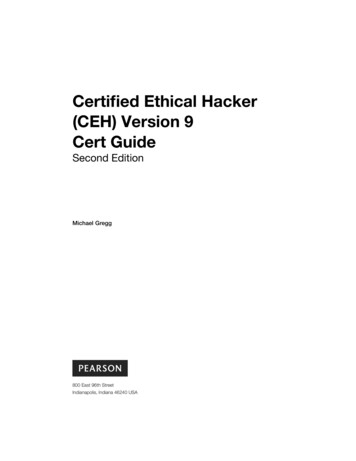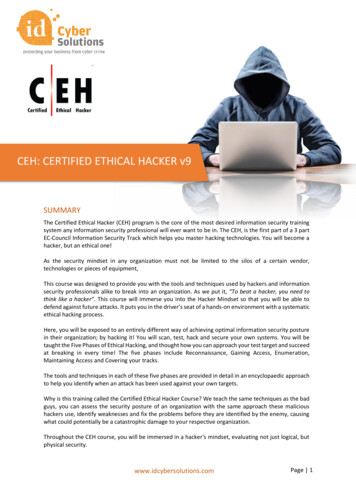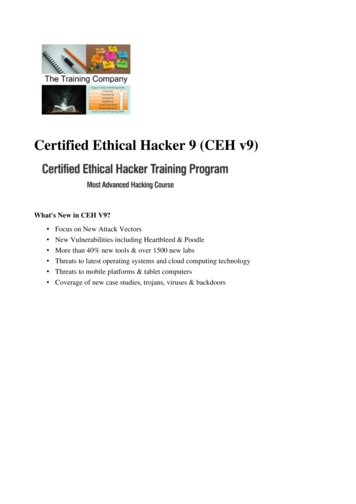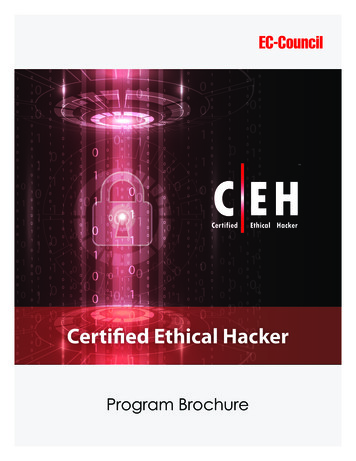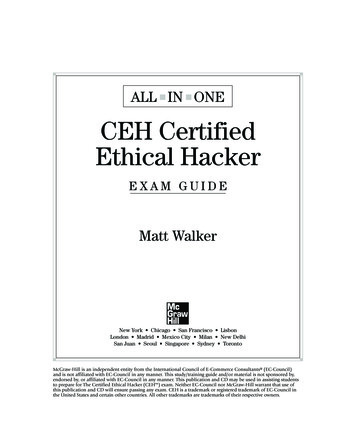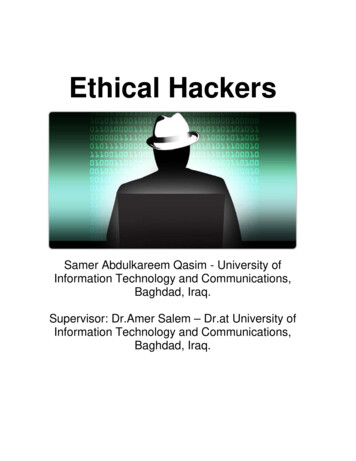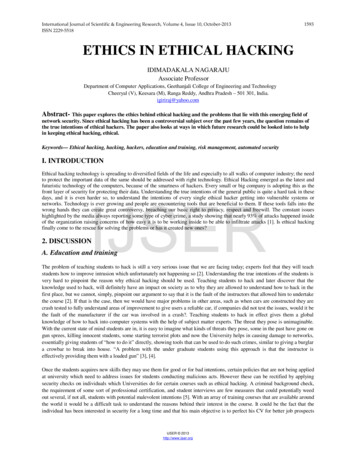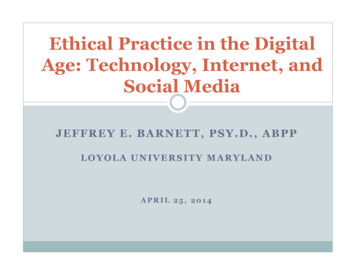
Transcription
Ethical Practice in the DigitalAge: Technology, Internet, andSocial MediaJEFFREY E. BARNETT, PSY.D., ABPPLOYOLA UNIVERSITY MARYLANDAPRIL 25, 2014
Disclosures landBoardofExaminersofPsychologists. ganizationsorofanyothers. interesttoreport.
The Provision of Mental Health Servicesin the Digital World What are Telehealth and E-Therapy? How has technology impacted how mental healthprofessionals provide professional services? Being a mental health professional in the digitalworld; ethical, legal, and clinical issues Can mental health professionals and their clients befriends? Electronic record keeping; riding the wave or watchout for that tsunami?
Telehealth, E-Therapy, andThe Use of Technology in Practice Telephones, Fax Machines, Cell Phones, E-mail, Etc. Administrative Uses Clinical Uses Ethics Issues, Challenges, and Concerns
Telehealth The use of telecommunications and informationtechnology to provide access to health assessment,intervention, consultation, supervision, education,and information across distance (Nickelson, 1998,p. 527). The use of the telephone, e-mail, chat rooms, andother internet and satellite-based technologies toprovide direct clinical services.
Clinical, Ethical and Legal Challenges Ability to adequately assess and diagnose anindividual who one does not see or interact with inperson. Missing nuances of interaction (visual cues) Handling emergencies and crises across longdistances Professional tone to the interactions andpreserving confidentiality Identity of client/legal ability to give consent Licensure issues; practicing across borders
Three Waves of Technological AdvancesThose that increase efficiency in running one’soffice.Those that presently enhance the provision ofclinical services.Those that are considered emerging technologies.
Technological AdvancesFirst Wave Technologies Photocopy and fax machinesWord processingVoice mail and answering machinesElectronic claim submissionSecond Wave Technologies Computerized test administration, scoring, andinterpretation Providing clinical services via the telephoneThird Wave Technologies Virtual reality treatments of anxiety disorders Interactive televideo communication treatments
Fourth Wave? Instantaneously translated global Televideo E-therapy via a Blackberry or I-Phone, etc.? Holographic virtual therapy? (Bell labs) Second Life Virtual World Psychotherapy?
Telephone The most widely used form of Telehealth(At least in 2000) ReferralsEmergency careConsultation and educationIndividual PsychotherapyClinical supervision91%79%71%69%58%(VandenBos & Williams, 2000)
Value of Telephone Treatment Homebound patients (e.g., agorophobia, physicallimitations, remote locale, etc.) Relative safety and anonymity of telephoneinteractions Ease of contact between appointments and duringcrises
E-mail and Text Messaging Administrative Uses Clinical UsesNo clear understanding of the effectiveness orappropriate use of e-mail as a therapeutic medium(Maheu & Gordon, 2000)
Ethics Issues Inability to guarantee confidentialityInformed consent proceduresUse of encryption softwareFirewall protection for your computers Provision of services across state lines Local jurisdiction legal requirements(e.g., mandatory reporting requirements) Not knowing the true identity of client
Clinical Issues Absence of visual and verbal cues Could be different people each contact Cultural differences that impact effectivecommunication Handling emergency situations and crises Client expectations for responsiveness
Teleconferencing andInteractive Televideo Communications Interactive Televideo Communications (IATV)Consultation and treatment to remote localessuch as deployed military personnel, rural settings,prisons or other settings lacking specializedtreatment professionalsEfficiency of service delivery/cost effectiveIncreased access to treatmentSuperior to telephone and e-mailTreatment across great distances
Back to the Future?
Areas of Concern with IATV Technological limitations impacting audio/visualacuity and clarity – interpersonal cues Inadvertent breaches of confidentiality Technology failures Difficulty responding to emergencies Licensure issues Knowledge of local laws Behavioral telehealth may not be the mostappropriate medium for all treatment needs
Legal and Ethical Issues 75% provide services across state lines 60% inquired about the patient’s state of residence 74% uncertain or incorrect about states’telemedicine or telehealth laws 50% made advanced arrangements for respondingto emergencies or crises 48% used a formal informed consent procedureprior to providing online services(Maheu & Gordon, 2000)
Recommendations Use a comprehensive informed consent procedure Learn relevant telehealth and telemedicine laws forall jurisdictions in which you will be providingservices Do not practice outside the scope of your license Follow your profession’s ethics code regardless ofthe therapeutic medium used Utilize all existing technology to protect eachindividual’s confidentiality
Recommendations (Cont.) Attend to issues of dangerousness, duty to warnand protect situations, and mandatory reportingrequirements Make arrangements in consumers’ local areas foremergency and crisis situations. Be knowledgeableof local resources Maintain appropriate liability coverage and be suremalpractice insurance covers these services Remain aware of the limitations of both the onlineservices provided and the technology used to offerthem
Recommendations (Cont.) Evaluate the effectiveness of all telehealth servicesprovided and modify them as needed Assess each individual’s appropriateness for thismodality of treatment. Make referrals whenneeded and appropriate Practice within your scope of practice and areas ofcompetence Attend to cultural, ethnic, language, and otherdifferences that may impact effectivecommunication
Recommendations (Cont.) Utilize effective documentation, adherence totermination and abandonment guidelines, andappropriate practices for fees and financialarrangements Ensure both clinical and technological competenceneeded to provide these services online Consult with knowledgeable colleagues, relevantstatutes, applicable ethics codes, availableprofessional standards, and legal counsel Participate in telehealth policy, standards,guidelines, and technology development
Uses of Telehealth Post-hospitalization home monitoring such as forcardiac rehab patients (Sparks, Shaw, Eddy,Hanigosky, & Vantrese, 1993) and for patients withInsulin-Dependent Diabetes (Bellazi et al., 2002). In Rehabilitation Psychology (Wade & Wolfe,2005). In hospice care and is known as Telehospice(Kinsella, 2005). In the treatment of problem gamblers (Griffiths &Cooper, 2003).
Uses of Telehealth (cont.) A psychoeducational and interactive behavioralInternet intervention for pediatric encopresis(Ritterband, et al., 2003). An online treatment program for panic disorder(Klein & Richards, 2001). To provide psychological and neuropsychologicalassessment services (Buchanan, 2002; Schopp,Johnstone, & Merrell, 2000).
Uses of Telehealth (cont.) For cognitive-behavioral family intervention forimproving child behavior and social competencefollowing head injury (Wade, Carey, and Wolfe,2006). Psychoeducational intervention for clients withschizophrenia and their families (Rotondi et al.,2005). To monitor and support medication use andtreatment effectiveness through daily textmessages of mood, symptom, and side effectratings to the clinician (Elliot, 2008).
Uses of Telehealth (cont.) Web based treatments for alcohol and nicotineaddition (Memelstein & Turner, 2006). Web based CBT treatment of PTSD (Knaevelsrud &Maercker, 2007) and web based treatment ofdepression, anxiety, and symptoms of PTSD withresults lasting over 18 months (Knaevelsrud &Maercker, 2010). Internet based CBT for social phobia demonstratingup to 30 months of improvement (Carlbring,Nordgren, Furmark, & Andersson, 2009).
TRICARE “U.S. Defense Dept: TRICARE Extends State-of-ArtWeb-based Counseling Program; Internet & WebCam To Speak "Face-To-Face" 24/7 Through the program, TRICARE health carebeneficiaries use the Internet and a Web cam tospeak "face-to-face" with mental-health counselorsaround the clock and from anywhere in the UnitedStates.”
TRICARE (cont.) “These services are available in the United Statesto active-duty service members, active-duty familymembers who are at least 18 years old,beneficiaries using TRICARE Reserve Select andbeneficiaries covered under the TransitionalAssistance Management Program, the release said.For some people, the online services aren't anappropriate level of care or video services aren'taccessible. In that case, a licensed professional willrefer the beneficiary to the right organization.”
Benefits of Telepsychology Increased Access to CareResidents of Rural AreasThe Geographically Isolated and the Homebound24/7 Access to CareLong Distance Consultation and Supervision
Benefits of Telepsychology (cont.) Delivery of Care to Special PopulationsChildren, the Elderly, Prison InmatesNative Americans and the DeafSymptom Monitoring of the RecentlyHospitalized and Those at Risk forHospitalizationThose who Might Not Otherwise Seek Treatment
Telepsychology and the Therapeutic Alliance A number of studies have found that the treatmentalliance in psychotherapy provided via IATV iscomparable to the therapeutic alliance found in inperson treatments (e.g., Cook & Doyle, 2002;Hanley, 2009; Morgan, Patrick, & Magaletta, 2008). But, more research is needed to fully understand thisand to see if different technologies promote differenteffects.
E-mail, Texting, and Social Networkingin American Today 73% of American adults are Internet users(Madden, 2006) (Up from 56% in 2001 – Jones,2002). Now 78.6% (Internet World Stats, 2012). 85% of undergraduate and graduate students owna computer and 72% of them check their E-mail atleast once each day; 82% of undergraduatestudents report participating in online socialnetworking sites (Caruso & Salaway, 2007).
E-mail, Texting, and Social Networkingin American Today (cont.) 82.5% of all undergraduate students surveyedreported participating in at least one socialnetworking site (ECAR, 2008). 56.8% of those participating in this surveyacknowledged daily use of social networking sites,an increase from 32.8% in just two years (ECAR,2008).
Cell Phones and Text Messaging Text messaging is available on over 98% of all cellphones worldwide and it does not require anyspecial applications or downloads for its use(CellSigns, 2009). While 18 billion text messages were sent via cellphones each month as of December 2006, thisnumber increased to 75 billion text messages eachmonth in June 2008. One American teenager was reported to have sentand received 6,473 text messages in one month (St.George, 2009).
Text Messaging Stats 18-24 year olds send or receive an average of 109.5text messages per day—that works out to more than3,200 messages per month (PewInternet.org, 2013). The average cellphone user in the U.S. send anaverage of 678 texts a month (Bits.com, 2013)
Cell Phones and Text Messaging (cont.) By 2006 30 countries had achieved 100% percapita cell phone use and two-thirds of cell phoneusers now report being active text messaging users(Mobile Marketing, 2009). At present there are 4.6 billion cell phonesubscriptions worldwide (Time, May 31, 2010, p.15). This includes 82% of adults in the U.S.(SnapGiant.com, 2013).
Worldwide Internet Access and Use Worldwide Internet use is reported at 25.6% withInternet use in North America reported at 74.2%(Internet World Stats, 2009) and 34.3% and78.6%, respectively, at present (World InternetStats, 2013). Internet use in North America is reported to haveincreased by 128.4% between 2000 and 2008(Internet World Stats, 2009) and 153% between2000 and 2012 (World Internet Stats, 2013).
A Novel Clinical Use of Text Messaging Mood 24/7 Mood 24/7 is a simple, highly practical tool used to helpthose affected by mental health conditions keep track oftheir moods. The combination of text messages and asecure website offer the user a unique means of creating amood chart without the need for keeping a daily journal.Once signed up using a secure website, a daily time may beselected for receiving a text message. The Mood 24/7message will simply ask to rate average mood on a scale ofone to ten, with 160 optional character annotations alsoavailable.
ABOUT Mood 24/7 “Whether you are seeing a physician or are just interested inmonitoring your mood, Mood 24/7 provides an easy way torecord how you're feeling. After registering, Mood 24/7 will askyou how you feel each day via a mobile text message. If you missa message, Mood 24/7 will send you a reminder later. You canprint your chart or share it online with friends, family, or amedical professional. Your privacy is important to us. Any information you submit toMood24/7 is yours alone and we will not share it with anyone,for any reason. To safeguard your information, we encrypt anypersonally identifiable information within our system. Readmore about Mood24/7’s privacy policy.”
Mood 24/7 (cont.) “After texting a response, the information received isused to make a mood chart, allowing a helpful andpractical means of identifying changes in moodsassociated with many common mental healthconditions, such as major depression and bipolardisorder.” Read more at: https://www.mood247.com/
Social Networking A wide range of Social Networking Sites exis
First Wave Technologies . ratings to the clinician (Elliot, 2008). Uses of Telehealth (cont.) Web based treatments for alcohol and nicotine addition (Memelstein & Turner, 2006). Web based CBT treatment of PTSD (Knaevelsrud & Maercker, 2007) and web based treatment of depression, anxiety, and symptoms of PTSD with results lasting over 18 months (Knaevelsrud & Maercker, 2010). Internet based .


